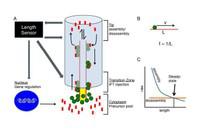Cells are not simply bags of enzymes, but rather are complex living machines with highly detailed and reproducible internal structures. Where does all of this geometry come from? Why do different types of cells have such different structures and forms? How could such complexity have arisen by evolution? These questions lie at the interface of biology and physics, however answers to these simple questions are almost completely unknown, and indeed the question of how complex structure can evolve has prompted some to seek supernatural explanations. In order to make the problem more tractable, we are seeking to study the origins of cellular geometry using the simplest possible cellular structures. One example is how cells determine the size of their organelles. Although it is generally assumed that the size of cellular structures has a direct impact on their function, we do not know how the cell controls the size of any of its parts. The question of size control has been hard to answer for most organelles because their complex three-dimensional structure makes their size difficult to measure. We have therefore turned to a geometrically simple structure, the cilium, as a model system. Our studies have revealed a remarkably simple mechanism that cells can use to control the size of this one particular structure, and we are now exploring how this type of mechanism may apply to other, more complicated organelles.
-

- Marshall: Illustration - Length

